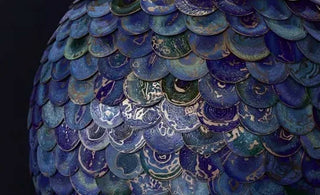
Chinese decor carries with it a rich history steeped in tradition, artistry, and cultural significance. Each piece tells a story, reflects centuries of craftsmanship, and embodies the essence of classical oriental art. The rich history behind Chinese decor is a tapestry woven from millennia of cultural, artistic, and philosophical development, reflecting the complexities and nuances of one of the world's oldest civilizations. In this article, we embark on a journey to explore the captivating world of Chinese decor, delving into its historical roots, symbolic motifs, and enduring allure. Join us as we uncover the fascinating tapestry of Chinese art and design.
The Origins of Chinese Decor
The roots of Chinese decor can be traced back to ancient times, as early as the Neolithic period. Early Chinese societies like the Yangshao and Longshan cultures were already producing pottery with geometric designs, indicative of an early appreciation for aesthetics. However, it was during the Shang and Zhou dynasties that decor began to take a more structured form, with bronze vessels and jade carvings embodying both functional and ceremonial purposes.Chinese decor finds its origins in the ancient dynasties that shaped the course of Chinese civilization. From the majestic Tang Dynasty to the refined Song Dynasty and the opulent Ming Dynasty, each era contributed unique elements to the world of Chinese art and design. These dynasties saw the flourishing of various art forms, such as porcelain, calligraphy, painting, and furniture making. The techniques and styles developed during these periods continue to influence and inspire contemporary Chinese decor.Each Chinese dynasty contributed its unique styles and motifs to the realm of decor. The Han Dynasty saw the emergence of intricate silk textiles and lacquerware. The Tang Dynasty brought about a cosmopolitan flair, with influences from the Silk Road leading to more vibrant and diverse decor. The Song and Yuan dynasties saw a move towards simplicity and naturalism, particularly in ceramic and porcelain wares. The Ming and Qing dynasties are particularly renowned for their contributions to furniture design, with the classic Ming style being celebrated for its elegance and simplicity.
Symbolism and Meaning of Chinese Decor
Chinese decor is infused with symbolism, where every motif and design element carries profound meaning. The lotus flower, for example, represents purity and enlightenment, while the dragon symbolizes power and prosperity. The phoenix embodies grace and beauty, while the peony signifies wealth and honor. Chinese decor is deeply influenced by the philosophical teachings of Confucianism, Taoism, and Buddhism. Confucian ideals emphasized order, harmony, and hierarchy, which were reflected in the symmetrical layouts and balanced designs of traditional Chinese spaces. Taoist and Buddhist influences brought a greater emphasis on nature, serenity, and the pursuit of spiritual harmony, which were expressed through garden design, the use of natural materials, and the depiction of mythological and natural motifs. These symbolic representations are meticulously incorporated into Chinese decor, allowing each piece to convey a specific message and evoke a particular emotion. By understanding the symbolism behind Chinese motifs, one can appreciate the depth and significance of each decorative element.Symbolism is a crucial aspect of Chinese decor, with various motifs representing different beliefs, virtues, and wishes. Dragons symbolize power and good luck, while phoenixes represent grace and virtue. Bats are symbolic of good fortune, and fish represent abundance. Floral motifs like lotus, peony, and chrysanthemum have their individual connotations, such as purity, wealth, and longevity.
Traditional Craftsmanship of Chinese Decor
Chinese decor is renowned for its exceptional craftsmanship, passed down through generations of skilled artisans. Traditional techniques such as porcelain making, cloisonné enamel, and wood carving have been perfected over centuries, resulting in exquisite pieces that are cherished for their beauty and intricacy. Chinese craftsmen employ meticulous attention to detail, often spending months or even years to create a single masterpiece. From the delicate brushstrokes of a painting to the precise carving of a wooden screen, the craftsmanship behind Chinese decor is a testament to the dedication and skill of its creators. Chinese decor utilizes a variety of materials and techniques to bring its designs to life. Porcelain, with its translucent beauty, is a hallmark of Chinese ceramics. The intricate blue and white patterns of Ming porcelain and the vibrant colors of Qing Dynasty porcelain are highly sought after by collectors and enthusiasts. Lacquerware, crafted by layering natural lacquer onto wooden surfaces, showcases a glossy and durable finish adorned with intricate designs. Silk, with its luxurious texture and vibrant colors, is used in tapestries, clothing, and upholstery. These materials, combined with techniques such as painting, carving, embroidery, and weaving, contribute to the diverse and captivating world of Chinese decor. Despite the passage of time, Chinese decor continues to captivate and inspire people around the globe. Its timeless elegance, intricate details, and cultural significance make it a sought-after choice for collectors, artists, and enthusiasts alike. Whether displayed in traditional settings or integrated into modern interior design, Chinese decor adds a touch of sophistication and a sense of history to any space. Its ability to transcend cultural boundaries and resonate with people from different backgrounds is a testament to its universal appeal.
In conclusion, the rich history behind Chinese decor is a testament to China's enduring cultural legacy. It is a history that speaks of dynastic changes, philosophical teachings, artistic advancements, and a deep understanding of harmony and balanceThe world of Chinese decor is a treasure trove of artistry, symbolism, and cultural heritage. Its roots lie deep in the annals of Chinese history, and its beauty continues to captivate the hearts and minds of individuals across generations. From the origins of Chinese decor to its symbolic motifs, traditional craftsmanship, and enduring appeal, each aspect contributes to the rich tapestry of this art form. Whether you are an artist seeking inspiration, a collector in search of timeless pieces, or an enthusiast with a passion for classical oriental art, Chinese decor offers a doorway into a world of beauty and cultural significance.























